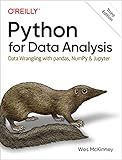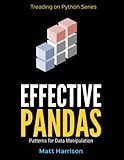Best Python Pandas Guides to Buy in December 2025

Python for Data Analysis: Data Wrangling with pandas, NumPy, and Jupyter



Pandas Cookbook: Practical recipes for scientific computing, time series, and exploratory data analysis using Python



Pandas for Everyone: Python Data Analysis (Addison-Wesley Data & Analytics Series)



Effective Pandas: Patterns for Data Manipulation (Treading on Python)



Pandas Workout: 200 exercises to make you a stronger data analyst



Pandas in Action



Hands-On Data Analysis with Pandas: A Python data science handbook for data collection, wrangling, analysis, and visualization


To create lists from pandas columns, you can use the tolist() method on a specific column of a pandas DataFrame. This method will convert the values in the column into a Python list. You can also use list comprehension to create lists from multiple columns in a DataFrame. Simply iterate over the columns and use the tolist() method to convert each column into a list. This can be useful when you need to extract specific data from a DataFrame and convert it into a list for further analysis or visualization.
How to create a list from a pandas column?
To create a list from a pandas column, you can use the following code:
import pandas as pd
create a sample DataFrame
data = {'A': [1, 2, 3, 4, 5]} df = pd.DataFrame(data)
extract values from a column and convert it to a list
column_values = df['A'].tolist()
print(column_values)
This code snippet creates a DataFrame with a column 'A' and then extracts the values from that column as a list using the tolist() method. You can replace 'A' with the name of the column that you want to convert to a list.
How to fill missing values in a pandas column?
There are several ways to fill missing values in a pandas column, depending on the nature of the data and the requirements of the analysis. Here are some common techniques:
- Replace missing values with a specific value:
import pandas as pd
Assuming df is your DataFrame and 'column_name' is the name of the column with missing values
df['column_name'].fillna(0, inplace=True) # Replace missing values with 0
- Replace missing values with the mean, median, or mode of the column:
mean_val = df['column_name'].mean() df['column_name'].fillna(mean_val, inplace=True) # Replace missing values with the mean
- Forward fill or backward fill missing values:
df['column_name'].fillna(method='ffill', inplace=True) # Forward fill missing values df['column_name'].fillna(method='bfill', inplace=True) # Backward fill missing values
- Interpolate missing values based on the existing data:
df['column_name'].interpolate(method='linear', inplace=True) # Interpolate missing values
- Replace missing values with the previous or next valid value:
df['column_name'].fillna(method='pad', inplace=True) # Replace missing values with the previous value df['column_name'].fillna(method='backfill', inplace=True) # Replace missing values with the next value
Choose the method that best fits your data and analysis needs. It's always a good practice to check how each method impacts your data before making a final decision.
What is the difference between loc and iloc in pandas?
loc is used for label-based indexing, where you specify the row and column labels you want to select, while iloc is used for integer-based indexing, where you specify the row and column indices you want to select.
In other words, loc uses the actual row and column labels from the DataFrame to make selections, while iloc uses the integer positions of the rows and columns.
For example, if you have a DataFrame with row labels "A", "B", "C", and column labels "X", "Y", "Z", using loc["A", "X"] will select the value at row "A" and column "X", while using iloc[0, 0] will select the value at the first row and first column.
How to drop a column in pandas?
You can drop a column in pandas using the .drop() method. Here is an example of how to drop a column named 'column_name' from a DataFrame:
import pandas as pd
Create a DataFrame
df = pd.DataFrame({ 'A': [1, 2, 3], 'B': [4, 5, 6], 'C': [7, 8, 9] })
Drop the 'B' column
df = df.drop('B', axis=1)
print(df)
This will output a DataFrame with the 'B' column dropped.
